By Paul B. Janeczko, Poet and Anthropologist
I love to visit schools and talk to young readers and writers about poetry. These visits give me the chance to preach. And I love to preach. I love to preach about the possibilities of  poetry. I find that too many readers, of all ages, have a very narrow view of poetry. Some readers think that poems must rhyme. Others believe that a good poem must follow a pattern, like a sonnet or a haiku. And there are still those whose feel that poems are all long, boring and stupid. Of course, some poems rhyme and some poems follow a form, and, alas, some poems are long, boring and stupid. But they don’t need to be. So, a big part of my job as a poet and a collector of poems is to create the books that will show readers the possibilities of poetry.
poetry. I find that too many readers, of all ages, have a very narrow view of poetry. Some readers think that poems must rhyme. Others believe that a good poem must follow a pattern, like a sonnet or a haiku. And there are still those whose feel that poems are all long, boring and stupid. Of course, some poems rhyme and some poems follow a form, and, alas, some poems are long, boring and stupid. But they don’t need to be. So, a big part of my job as a poet and a collector of poems is to create the books that will show readers the possibilities of poetry.
I want readers to see that poetry is accessible, that it’s something that captures experiences, that it captures the meanings in life, and that it communicates with language wild and marvelous. I want kids to know that poems can narrate, provoke, console and even commemorate. Good poetry explodes with possibilities, and we must share those possibilities with young people.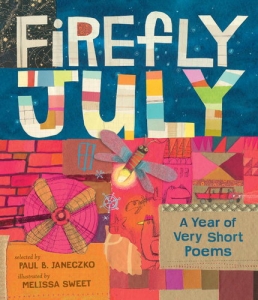
I’ve come to realize that one of the reasons I create poetry anthologies is to give readers, kids or not, the chance to experience the possibilities of poetry. I want young readers to see that poetry has functions other than to puzzle, intimidate and infuriate. Poetry can mesmerize, mock and mimic. Poetry can celebrate. Poetry can, of course, narrate the stories of our lives.
I never want my latest anthology to be just “another poetry anthology.” Rather, I want each anthology to show students and teachers different types of poems. For example, I created Firefly July: A Year of Very Short Poems, my latest anthology, because I wanted kids and teachers to see that when it comes to poetry, size doesn’t matter. That a good poem can capture a stunning image in few words. Indeed, each of my recent poetry anthologies spotlights the possibilities of poetry. For example:
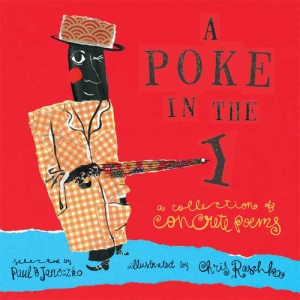 |
A Poke in the I is a collection of concrete or shape poems. |
| A Kick in the Head is “an everyday guide to poetic forms,” a treasure chest of poetic possibilities. |
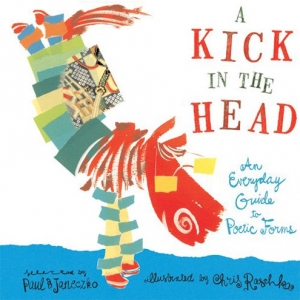 |
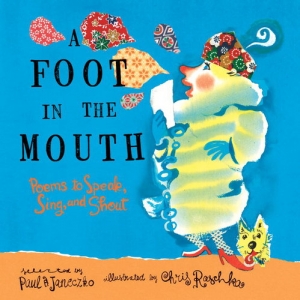 |
A Foot in the Mouth includes poems that show the magic of reading a poem aloud. |
| Dirty Laundry Pile is a book of persona or mask poems. | 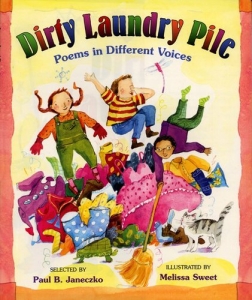 |
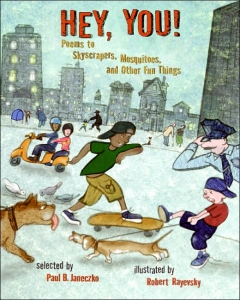 |
Hey, You! contains poems of address. |
| The Death of the Hat contains poems through history reflecting the time in which each poet lived. |
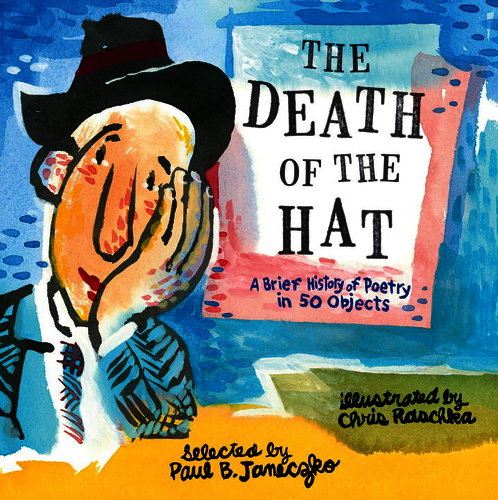 |
It is up to all of us to allow young people plenty of opportunities to experience poetry. To feel what Robert Francis meant when he said, “One word cannot strike spark from itself; it takes at least two for that. It takes words lying side by side to breed wonders.” The choices we can give kids are nearly limitless. Kids can read and write: elegies, parodies,  rondeaux and plain odes, clerihew, haiku, epigrams and epitaphs, concrete poems, found poems, synonym poems, acrostic poems, light verse, blank verse, free verse, lyrics, limericks, epics, couplets and tercets, sonnets (Elizabethan and Italian), refrains and quatrains. Possibilities!
rondeaux and plain odes, clerihew, haiku, epigrams and epitaphs, concrete poems, found poems, synonym poems, acrostic poems, light verse, blank verse, free verse, lyrics, limericks, epics, couplets and tercets, sonnets (Elizabethan and Italian), refrains and quatrains. Possibilities!
The best poems ask questions we all ask. The best poems are like life itself: they celebrate the grace of little things. The best poems are alive with intense, inventive language. Mark Twain said that the difference between the right word and the almost right word is like the difference between lightning and a lightning bug. Nowhere is that more crucial than in poetry.
When I am moved by a good poem, as I hope all readers are, I recall the words of Stanley Kunitz, who said that if we listen hard enough to poets, “who knows–we too may break into dance, perhaps for grief, perhaps for joy.”
Written by Paul B. Janeczko, poet and anthropologist. His numerous publications include poetry anthologies, guides for young writers and books for teachers. Find Paul on his Facebook page or on his website.




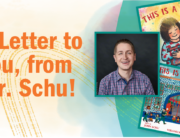
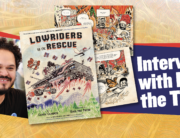
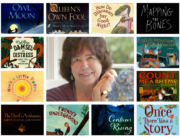
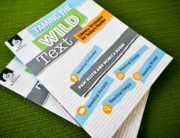
Leave A Comment